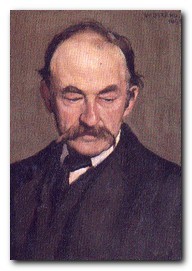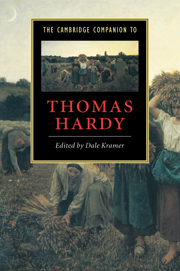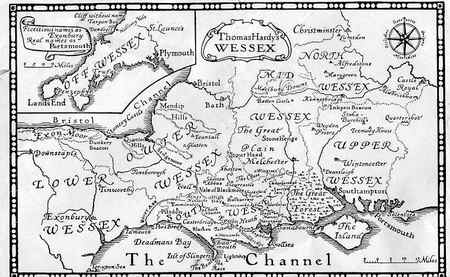tutorial, commentary, web links, and study resources
A Pair of Blue Eyes was Thomas Hardy’s fourth novel, the first to be published under his own name, and the first to be serialised. It was published in Tinsleys’ Magazine in eleven monthly instalments between September 1872 and July 1873. Then it was produced as a novel in three volumes by Tinsley Brothers later the same year. The three-volume novel was very popular during the nineteenth century – a publishing format largely dictated by the rise of the commercial circulating libraries. It is the most heavily revised of all Hardy’s novels.
Thomas Hardy
A Pair of Blue Eyes – critical commentary
The principal features of interest in this early Hardy novel are its three main characters – Stephen Smith, Elfride Swancourt, and Henry Knight. It is fairly obvious that Hardy divided the two ‘sides’ of his own aspirations between Stephen and Knight. Stephen is the would-be architect – the profession which Hardy himself actually practised. But whilst working as a draftsman in London, Hardy also aspired to literature as a career – without knowing at first which would be successful. And interestingly enough, Henry Knight also has two occupations – as a barrister and as a literary editor, though we see precious little evidence of practical application in the first, and only vague reports of the second.
Stephen Smith
The main driving force behind Stephen is his desire for self-improvement. He comes from a humble, but reasonably respectable background. His parents are workers on the Luxellian estate. He has been educated at a National school – institutions which were established for the education of the poor in the early part of the nineteenth century. After that his learning has been conducted by correspondence with his friend Henry Knight – which leaves Stephen with no practical knowledge of how to hold chess pieces or how to pronounce words in Latin.
Although Stephen has embarked on a career in architecture, it is worth noting that he has done so as an ‘improver’ – what we would today call an ‘intern’. That is, his parents have paid for him to gain experience in the hope of future employment in the profession. This explains Stephen’s secrecy and mysterious movements in the early part of the novel. He is moving in circles well above his own class background and feels insecure about being found out. Reverend Swancourt has assumed that Stephen is a young professional, which explains the reversal in his opinions and his ban on Stephen when he discovers that he is from humble origins. It of course illustrates at the same time the arriviste snobbery of Reverend Swancourt, who goes on to marry an ugly woman he doesn’t love for the sake of her wealth.
Henry Knight
Knight is the epitome of academic book-learning with no comparable emotional development. He is university educated, presumably has qualifications in law since he practises as a barrister (theoretically) and is an editor on The Present which has the reputation of a leading intellectual journal. But emotionally he is a possessive child who cannot tolerate the idea that his chosen love object has any connection with previous admirers. He also subjects Elfride to an extensive bombardment of self-righteous emotional bullying to extract information about her ‘past’. As J.M.Barrie observed, he is “simply the most insufferable prig in fiction”.
Elfride Swancourt
Elfride is a typical Hardy heroine – and it must be said something of a fictional construct rather than a realistic piece of characterisation. She is a very talented young woman: she plays the piano (and the organ); she sings; she plays chess; she writes a novel; and she holds quasi-philosophic conversations with Henry Knight. These talents might endear her to readers (and especially critics) seeking early examples of ‘the New Woman’ in Victorian fiction – but they do not add up to an entirely credible character.
It has to be said that she is in summary rather inconstant. Within the timespan of the novel she has four lovers. First Felix Jethway, who dies of love for her, according to his mother. Then Stephen Smith, with whom she is prepared to elope – but then changes her mind at the last minute. Next comes Henry Knight, overlapping with Stephen emotionally, but who eventually wins the higher ground. But when he withdraws his attentions on an emotionally costive principle, she fairly soon switches her attentions to the untalented Lord Luxellian – then marries him. Psycho-analytic interpretations of the novel might well then observe that she is ‘punished’ by dying in childbirth.
Structure
The twinning, repetition, and parallelism in the novel should be fairly evident.
Elfride plays chess twice – first with Stephen, then with Henry Knight. She loses an ear ring when kissing Stephen on the cliff; she later accepts Knight’s gift of ear rings; and then recovers the lost ear ring when with Knight in the same location.
Elfride walks on the parapet of the church tower – and falls off it – whilst she is with Knight. He then falls off the cliff whilst he is with Elfride. She also sits on the grave of Felix Jethway when she is with Stephen, then later when she is with Knight.
Coincidence
Many of Hardy’s plots rely on coincidence to an extent that some modern readers find rather taxing to their credulity. The use of this literary device was fairly common in the fiction of the late nineteenth century (and had been since Dickens was so popular in the middle of the century).
When Stephen and Elfride return from their failed elopement to Plymouth and London, their surreptitious arrival together is witnessed by none other than Mrs Jethway. She is the one person who has a motive for exposing Elfride’s reputation to public scrutiny – since her son was Elfride’s first lover, and died because of it – according to her.
This secret knowledge creates an element of suspense in the plot until Mrs Jethway is crushed by the collapse of the church tower – but only immediately after having written the letter to Knight exposing what she knows, and enclosing proof in the form of Elfride’s letter pleading for secrecy.
The example is important because a great deal of the tension and suspense in the plot rests on the possible disclosure of this knowledge. Mrs Jethway flits in and out of events, appearing at crucial moments, but withholding her information until the last minute.
A less important example, because nothing vital in the development of events rests upon it, is the coincidence that not only do Stephen and Knight get on the same train to revisit Endelstow, but the carriage transporting Elfride’s corpse is attached to it on the journey.
Similarly, there is a tension between probability and plot symmetry when Stephen and Knight visit the crypt to pay their last respects to Elfride – only to find Lord Luxellian there mourning his dead wife. So – all three of her lovers are brought together for the final scene, and the fourth is quite near too, in the graveyard outside. This is strained plotting on Hardy’s part, but nothing further in the story depends upon the melodramatic conjunction.
Loose ends
The issue of Elfride’s novel and Knight’s subsequent review of it brings the two characters together for the second dramatic strand of the novel – but once she has rescued him from hanging on the cliff, her literary skills appear to be forgotten. They form no further part of the drama.
Henry Knight has barrister’s offices in the City and a home out in Richmond. We are led to believe that he has been a reviewer on the magazine The Present but has risen to be something like a senior editor. His offices are littered with the impedimenta of an active editor – but there isn’t the slightest scrap of evidence that he practises as a man of law anywhere in the novel. It’s almost as if Hardy conceived Knight with one profession, changed his mind, and forgot to erase traces of his first choice.
Study resources
![]() A Pair of Blue Eyes – Oxford World Classics edition – Amazon UK
A Pair of Blue Eyes – Oxford World Classics edition – Amazon UK
![]() A Pair of Blue Eyes – Oxford World Classics edition – Amazon US
A Pair of Blue Eyes – Oxford World Classics edition – Amazon US
![]() A Pair of Blue Eyes – Wordsworth Classics edition – Amazon UK
A Pair of Blue Eyes – Wordsworth Classics edition – Amazon UK
![]() A Pair of Blue Eyes – Wordsworth Classics edition – Amazon US
A Pair of Blue Eyes – Wordsworth Classics edition – Amazon US
![]() The Complete Works of Thomas Hardy – Kindle eBook
The Complete Works of Thomas Hardy – Kindle eBook
![]() A Pair of Blue Eyes – eBook formats at Project Gutenberg
A Pair of Blue Eyes – eBook formats at Project Gutenberg
![]() A Pair of Blue Eyes – audiobook version at LibriVox.org
A Pair of Blue Eyes – audiobook version at LibriVox.org
![]() The Cambridge Companion to Thomas Hardy – Amazon UK
The Cambridge Companion to Thomas Hardy – Amazon UK
![]() The Complete Critical Guide to Thomas Hardy – Amazon UK
The Complete Critical Guide to Thomas Hardy – Amazon UK
![]() Authors in Context – Thomas Hardy – Amazon UK
Authors in Context – Thomas Hardy – Amazon UK
![]() Oxford Reader’s Companion to Hardy – Amazon UK
Oxford Reader’s Companion to Hardy – Amazon UK
A Pair of Blue Eyes – story synopsis
Chapter I. Elfride Swancourt is in Endelstow, nervously awaiting the arrival of Stephen Smith from London.
Chapter II. Stephen arrives at the rectory to make a survey of the church aisle and its tower for a restoration project.
Chapter III. The rector Christopher Swancourt is very enthusiastic about Stephen and thinks he must have aristocratic family connections (which is not true). Elfride sings for Stephen, and they are both very impressed with each other.
Chapter IV. Stephen surveys the church with Swancourt and his helper William Worm. Stephen promises to signal Elfride from the tower, but fails to do so.
Chapter V. Stephen receives news that he ought to be back in London, and Swancourt is asked to retrieve a document for the local landowner Lord Luxellian. Stephen, Swancourt, and Elfride go to Endelstow House, where she is the favourite of Mary and Kate, the Luxellian children. Stephen disappears briefly but mysteriously, and appears to meet a woman.
Chapter VI. Elfride is mystified by Stephen, who appears to be hiding something. She tries to extract the secret from him without success. Stephen departs, promising to return.
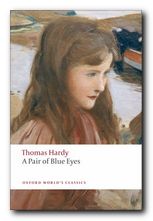 Chapter VII. At his next visit to the rectory, Stephen plays chess with Elfride, which he has taught himself from books. He has also learned Latin by post from his friend Mr Knight. Stephen tells Elfride that he loves her. They go together up onto the cliffs to continue their flirtations. They exchange their first kiss, she loses an ear ring, and they declare their love for each other. But Stephen suggests that there is something which will prevent their marrying.
Chapter VII. At his next visit to the rectory, Stephen plays chess with Elfride, which he has taught himself from books. He has also learned Latin by post from his friend Mr Knight. Stephen tells Elfride that he loves her. They go together up onto the cliffs to continue their flirtations. They exchange their first kiss, she loses an ear ring, and they declare their love for each other. But Stephen suggests that there is something which will prevent their marrying.
Chapter VIII. They return to the rectory. Stephen is due to ask the reverend Swancourt for permission to marry Elfride, but he changes his mind and delays. Instead, he reveals his humble family origins: his mother and father are workers on the Luxellian estate, and his education has been via National school and his friend Henry Knight.
Chapter IX. Stephen’s father is injured in an accident at the church restoration. Whilst Stephen visits his family home, the reverend Swancourt upbraids Elfride for forming an attachment to a commoner and forbids any engagement.
Chapter X. Stephen visits his parents and spars with his mother about marriage and social class. She does not approve of Elfride. As he prepares to leave the rectory, he and Elfride hatch a plan to marry in secret.
Chapter XI. Elfride discovers that he father has been conducting a secret correspondence, and he has a plan in mind for making them rich. She leaves the rectory secretly and travels indecisively to Plymouth to be married. But Stephen has registered the marriage in London – so they travel on there.
Chapter XII. As soon as they reach London, Elfride changes her mind and they travel back to Endelstow – observed as they arrive together by Mrs Jethway. When she reaches home, Elfride is met by her father, who has married Mrs Troyton, a rich and plain widow who has bought the neighbouring estate. He claims it was done for Elfride’s sake. Mrs Troyton is old and rather flamboyant.
Chapter XIII. Two months later Stephen visits his old friend Henry Knight in his London offices and asks his advice about accepting a job offer in India in order to save up to get married. Knight thinks the decision turns on the issue of the fidelity of the individuals during such a prolonged absence. He also has Elfride’s romantic novel to review.
Chapter XIV. Some months later Elfride is living in Kensington and mixing in upper-class society because of the wealth and connections of her new step-mother. Her romantic novel is being reviewed. Mrs Troyton (now Mrs Swancourt) meets her distant relative Henry Knight in Hyde Park and invites him to visit them in Cornwall.
Chapter XV. Elfride reads Henry Knight’s review of her romantic novel, which contains some strong criticism.
Chapter XVI. Elfride writes to the journal The Present and receives a reply from Knight, who is shortly to visit Endelstow.
Chapter XVII. Henry Knight arrives at Endelstow and engages in some (rather improbable) philosophic discussions with Elfride, stemming from his review of her novel.
Chapter XVIII. Elfride shows Knight the local church and walks round the parapet of its tower, where she falls off. She then plays chess with him, and is beaten. She flirts with him and tries to extract compliments, but he refuses to flatter her and will only tell her about his preferences and the truth as he sees it.
Chapter XIX. Knight reads from the Bible in the local church service whilst Elfride plays the organ – both of them observed from the back of the congregation by Mrs Jethway. Elfride asks the rather pompous Knight for guidance on vanity and women’s nature – subjects on which he has lots of theory but no practical knowledge.
Chapter XX. Knight travels to Ireland and realises that he has fallen in love with Elfride. He buys her some ear rings, but she feels that she should refuse to accept them. Meanwhile Stephen sends her £200 he has saved towards their marriage, and is then despatched on a visit back to England to make building procurements for his work.
Chapter XXI. Elfride goes onto the cliffs to watch for Stephen’s arrival back in England. There she meets Knight, and they become trapped on the cliff top. Elfride climbs up Knight to safety, but he remains stuck on a ledge.
Chapter XXII. Knight clings to the cliff edge expecting to die, but Elfride saves him by tearing up her underclothes and making a rope with which he is hauled to safety – after which they embrace passionately with relief.
Chapter XXIII. Stephen lands ashore and walking home sees Elfride and Knight in retreat from the cliff. He arrives at his family house to be greeted by conversations amongst his family and locals about flowers and pig-killing. He feels snobbishly resentful of the company.
Chapter XXIV. Elfride fails to turn up to a planned meeting with Stephen, and she returns the £200 he has sent. Next day he travels to Birmingham to order his procurements.
Chapter XXV. On return from Birmingham Stephen sees Elfride with Knight. He is also intercepted by Mrs Jethway who warns him against Elfride. As he makes his way home in a state of desolation, he learns that Lady Luxellian has died.
Chapter XXVI. There is a discussion in the Luxellian family crypt regarding family history, questions of inheritance, and Elfride’s personal history.
Chapter XXVII. Elfride’s change of heart in choosing Knight is explained whilst they are out riding. They visit the Luxellian crypt and meet Stephen. Elfride is worried about not having told Knight about her past relationship with Stephen.
Chapter XXVIII. Elfride plans to reveal the truth about her past to Knight, but cannot face it when the time comes. They ride out to a watery glade where she now accepts his gift of the ear rings. Mrs Jethway turns up to reveal that she has damaging information – but will not use it just yet.
Chapter XXIX. The Swancourts go on holiday to Europe, returning from London to Cornwall via a boat journey in the Channel. Mrs Jethway makes an appearance, which worries Elfride. She discusses the subject of ‘previous romantic experience’ with Knight who has none and assumes she has none either.
Chapter XXX. Elfride finally reveals in discussion with Knight that she has previously had a ‘lover’. She delivers a note to Mrs Jethway, pleading with her not to reveal details of her liaison with Stephen. Knight begins to put together fragments of her previous comments, and his suspicions make him unhappy.
Chapter XXXI. Elfride and Knight go up onto the cliffs, where she finds her lost ear ring. Knight continues to harass her for information about her past and wants to know what she is keeping secret from him. He admits that he is jealous and can only accept a wife who has absolutely no previous experience. Meanwhile, the church tower collapses.
Chapter XXXII. Knight and Elfride go into the churchyard and sit on Felix Jethway’s gravestone. Knight pesters her further about her past. She first of all she hides behind an ambiguous blend of information about Stephen and Felix Jethway. Then eventually she is forced to admit that there were two former lovers. Knight badgers her into giving him the full story.
Chapter XXXIII. Stephen finds Mrs Jethway crushed in the tower ruins. Lord Luxellian turns up, and they take the body back to her house, where Stephen sees that she has been writing a warning letter to someone.
Chapter XXXIV. Next day Knight receives the latter Mrs Jethway was writing, plus Elfride’s pleading note to Mrs Jethway. He challenges Elfride again, and she admits to having been away overnight with Stephen on her journey to London. Knight immediately breaks off their engagement and goes back to his chambers in London.
Chapter XXXV. Next morning Elfride turns up at his offices, begging him not to leave her – but her father then appears and takes her away again. Knight is in deep conflict over his feelings for Elfride, but he ends up closing his offices and going abroad.
Chapter XXXVI. Some time passes. Stephen’s parents move to St Launce’s where they hear news of his architectural success in India.
Chapter XXXVII. Knight travels extensively but pointlessly in Europe. More than a year later Stephen and Knight meet by accident in London. They compare notes about the fact that neither of them is married; but they are very reserved with each other.
Chapter XXXVIII. The two men meet again in the evening, and eventually Stephen reveals the whole story of his romance with Elfride to Knight. This rekindles the interest of both men in Elfride: Stephen still loves her and thinks Knight has been rejected; Knight ‘forgives’ Elfride retrospectively and thinks Stephen is no serious rival.
Chapter XXXIX. The two men claim to have urgent business, but in fact they give each other the slip in order to get to Elfride as soon as possible. They meet on the same train, and admit that they are both en route to ask for her hand in marriage. They continue to argue about who has the more valid claim to Elfride. Meanwhile, the train has a ‘death coach’ attached to it. When they reach their destination, they are met by a hearse – and they discover it is for Elfride.
Chapter XL. They then learn after the death of Lady Luxellian, Elfride became the ‘little mother’ to the two Luxellian children, as a result of which she eventually married Lord Luxellian. But after travelling abroad she died of a miscarriage in London. Stephen and Knight decide to visit the Luxellian vault in the church, but when they get there they find Lord Luxellian grieving for his dead wife – so they both leave.
A Pair of Blue Eyes – principal characters
| Reverend Swancourt | a deaf, widowed, and largely bankrupt rector |
| Elfride Swancourt | his pretty and clever young daughter |
| John Smith | a master-mason on the Luxellian estate |
| Stephen Smith | his young son, working in a London architect’s office |
| William Worm | a bumpkin, with noises in his head |
| Henry Knight | a barrister, literary editor, and distant relative of Mrs Troyton |
| Lord Spencer Hugo Luxellian | local landowner, with ‘no talent’ |
| Mary and Kate | his two young daughters |
| Mrs Gertrude Jethway | a poor and embittered widow, mother of Elfride’s first lover |
| Felix Jethway | Elfride’s first lover |
| Mrs Charlotte Troyton | a rich but plain widow who buys an estate next to Swancourt |
| Robert Lickpan | a pig-killer |
| Martin Cannister | a sexton |
A Pair of Blue Eyes – bibliography
Laura Green, ‘”Strange [In]difference of Sex”: Thomas Hardy, the Victorian Man of Letters and the Temptations of Androgyny’, Victorian Studies 38/4 (1995), 523-50.
John Halperin, ‘Leslie Stephen, Thomas Hardy, and A Pair of Blue Eyes‘, Modern Language Review, 75 (1980), 738-45.
Rosemarie Morgan, Women and Sexuality in the Novels of Thomas Hardy, (London, Routledge, 1988).
Angelique Richardson, ‘”Some Science Underlies All Art”: The Dramatization of Sexual Selection and Racial Biology in A Pair of Blue Eyes and The Well-Beloved‘, Journal of Victorian Culture, 3/2 (1998), 302-38.
Mary Rimmer, ‘Club Laws: Chess and Construction of Gender in A Pair of Blue Eyes‘, in Margaret R. Higonnet (ed), The Sense of Sex: Feminist Perspectives on Hardy (Urbana: University of Illinois Press, 1993), 203-20.
Robert Schweik, ‘”Life and Death are Neighbours Nigh”: Hardy’s A Pair of Blue Eyes and the Uses of Incongruity, Philological Quarterly, 76/1 (1997), 87-100.
Rosemary Sumner, A Route to Modernism: Hardy, Lawrence, Woolf (Basingstoke: Macmillan, 1999).
Richard H. Taylor, The Neglected Hardy: Thomas Hardy’s Lesser Novels (Basingstoke: Macmillan 1982).
Jane Thomas, Thomas Hardy, Femininity and Dissent: Reassessing the Minor Novels (Basingstoke: Macmillan, 1999).
Hardy’s WESSEX
Further reading
![]() John Bayley, An Essay on Hardy, Cambridge: Cambridge University Press, 1978.
John Bayley, An Essay on Hardy, Cambridge: Cambridge University Press, 1978.
![]() Penny Boumelha, Thomas Hardy and Women: Sexual Ideology and Narrative Form, Brighton: Harvester, 1982.
Penny Boumelha, Thomas Hardy and Women: Sexual Ideology and Narrative Form, Brighton: Harvester, 1982.
![]() Kristin Brady, The Short Stories of Thomas Hardy, London: Macmillan, 1982.
Kristin Brady, The Short Stories of Thomas Hardy, London: Macmillan, 1982.
![]() L. St.J. Butler, Alternative Hardy, London: Macmillan, 1989.
L. St.J. Butler, Alternative Hardy, London: Macmillan, 1989.
![]() Raymond Chapman, The Language of Thomas Hardy, London: Macmillan, 1990.
Raymond Chapman, The Language of Thomas Hardy, London: Macmillan, 1990.
![]() R.G.Cox, Thomas Hardy: The Critical Heritage, London: Routledge and Keegan Paul, 1970.
R.G.Cox, Thomas Hardy: The Critical Heritage, London: Routledge and Keegan Paul, 1970.
![]() Ralph W.V. Elliot, Thomas Hardy’s English, Oxford: Basil Blackwell, 1984.
Ralph W.V. Elliot, Thomas Hardy’s English, Oxford: Basil Blackwell, 1984.
![]() James Gibson (ed), The Complete Poems of Thomas Hardy, London, 1976.
James Gibson (ed), The Complete Poems of Thomas Hardy, London, 1976.
![]() Florence Emily Hardy, The Life of Thomas Hardy, London: Macmillan, 1962. (This is more or less Hardy’ s autobiography, since he told his wife what to write.)
Florence Emily Hardy, The Life of Thomas Hardy, London: Macmillan, 1962. (This is more or less Hardy’ s autobiography, since he told his wife what to write.)
![]() P. Ingham, Thomas Hardy: A Feminist Reading, Brighton: Harvester, 1989.
P. Ingham, Thomas Hardy: A Feminist Reading, Brighton: Harvester, 1989.
![]() P.Ingham, The Language of Class and Gender: Transformation in the English Novel, London: Routledge, 1995,
P.Ingham, The Language of Class and Gender: Transformation in the English Novel, London: Routledge, 1995,
![]() Michael Millgate, Thomas Hardy: His Career as a Novelist, London: Bodley Head, 1971.
Michael Millgate, Thomas Hardy: His Career as a Novelist, London: Bodley Head, 1971.
![]() Michael Millgate, Thomas Hardy: A Biography Revisited, Oxford: Clarendon Press, 2006. (This is the definitive biography.)
Michael Millgate, Thomas Hardy: A Biography Revisited, Oxford: Clarendon Press, 2006. (This is the definitive biography.)
![]() Michael Millgate and Richard L. Purdy (eds), The Collected Letters of Thomas Hardy, Oxford: Clarendon Press, 1978-
Michael Millgate and Richard L. Purdy (eds), The Collected Letters of Thomas Hardy, Oxford: Clarendon Press, 1978-
![]() R. Morgan, Women and Sexuality in the Novels of Thomas Hardy, London: Routledge, 1988.
R. Morgan, Women and Sexuality in the Novels of Thomas Hardy, London: Routledge, 1988.
![]() Harold Orel (ed), Thomas Hardy’s Personal Writings, London, 1967.
Harold Orel (ed), Thomas Hardy’s Personal Writings, London, 1967.
![]() F.B. Pinion, A Thomas Hardy Companion, London: Macmillan, 1968.
F.B. Pinion, A Thomas Hardy Companion, London: Macmillan, 1968.
![]() Norman Page, Thomas Hardy, London: Routledge & Keegan Paul, 1977.
Norman Page, Thomas Hardy, London: Routledge & Keegan Paul, 1977.
![]() Rosemary Sumner, Thomas Hardy: Psychological Novelist, London: Macmillan, 1981.
Rosemary Sumner, Thomas Hardy: Psychological Novelist, London: Macmillan, 1981.
![]() Richard H. Taylor, The Personal Notebooks of Thomas Hardy, London, 1978.
Richard H. Taylor, The Personal Notebooks of Thomas Hardy, London, 1978.
![]() Merryn Williams, A Preface to Hardy, London: Longman, 1976.
Merryn Williams, A Preface to Hardy, London: Longman, 1976.
Hardy’s study
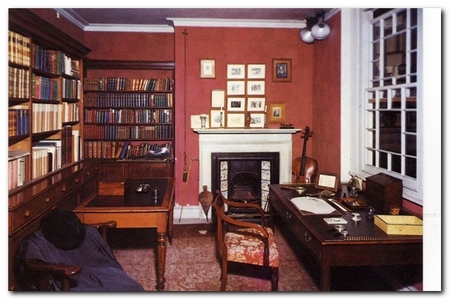
reconstructed in Dorchester museum
Other works by Thomas Hardy
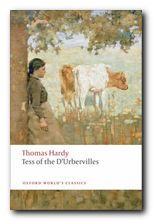 Tess of the d’Urbervilles (1891) is probably the most popular of Hardy’s late, great novels. The sub-title is ‘A Pure Woman’, and it is a story which explores the tragic consequences of a young milkmaid who becomes the victim of the men she encounters. First she falls for the spiritual but flawed Angel Clare, and then the physical but limited Alec Durberville takes advantage of her. This novel has some of the most beautiful and the most harrowing depictions of rural working conditions which reveal Hardy as a passionate advocate for those who work the land. It also has a wonderfully symbolic climax at Stonehenge on Salisbury Plain. There is poetry in almost every page.
Tess of the d’Urbervilles (1891) is probably the most popular of Hardy’s late, great novels. The sub-title is ‘A Pure Woman’, and it is a story which explores the tragic consequences of a young milkmaid who becomes the victim of the men she encounters. First she falls for the spiritual but flawed Angel Clare, and then the physical but limited Alec Durberville takes advantage of her. This novel has some of the most beautiful and the most harrowing depictions of rural working conditions which reveal Hardy as a passionate advocate for those who work the land. It also has a wonderfully symbolic climax at Stonehenge on Salisbury Plain. There is poetry in almost every page.
![]() Buy the book at Amazon UK
Buy the book at Amazon UK
![]() Buy the book at Amazon US
Buy the book at Amazon US
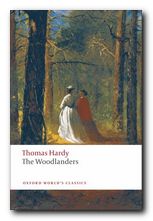 The Woodlanders (1887) Giles Winterbourne, an honest woodsman, suffers with the many tribulations of his selfless love for Grace Melbury, a woman above his station in this classic tale of the West Country. She marries the new doctor, Edred Fitzpiers, but leaves him when she learns he has been unfaithful. She turns instead to Giles, who nobly allows her to sleep in his house during stormy weather, whilst he sleeps outside and brings on his own death. It’s often said that the hero of this novel is the woods themselves – so deeply moving is Hardy’s account of the timbered countryside which provides the backdrop for another human tragedy and a study of rural life in transition.
The Woodlanders (1887) Giles Winterbourne, an honest woodsman, suffers with the many tribulations of his selfless love for Grace Melbury, a woman above his station in this classic tale of the West Country. She marries the new doctor, Edred Fitzpiers, but leaves him when she learns he has been unfaithful. She turns instead to Giles, who nobly allows her to sleep in his house during stormy weather, whilst he sleeps outside and brings on his own death. It’s often said that the hero of this novel is the woods themselves – so deeply moving is Hardy’s account of the timbered countryside which provides the backdrop for another human tragedy and a study of rural life in transition.
![]() Buy the book at Amazon UK
Buy the book at Amazon UK
![]() Buy the book at Amazon US
Buy the book at Amazon US
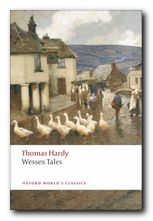 Wessex Tales Don’t miss the skills of Hardy as a writer of shorter fictions. None of his short stories are really short, but they are beautifully crafted. This is the first volume of his tales in which he was seeking to record the customs, superstitions, and beliefs of old Wessex before they were lost to living memory. Yet whilst dealing with traditional beliefs, they also explore very modern concerns of difficult and often thwarted human passions which he developed more extensively in his longer works.
Wessex Tales Don’t miss the skills of Hardy as a writer of shorter fictions. None of his short stories are really short, but they are beautifully crafted. This is the first volume of his tales in which he was seeking to record the customs, superstitions, and beliefs of old Wessex before they were lost to living memory. Yet whilst dealing with traditional beliefs, they also explore very modern concerns of difficult and often thwarted human passions which he developed more extensively in his longer works.
![]() Buy the book at Amazon UK
Buy the book at Amazon UK
![]() Buy the book at Amazon US
Buy the book at Amazon US
Thomas Hardy – web links
Thomas Hardy at Mantex
Biographical notes, study guides to the major novels, book reviews. bibliographies, critiques of the shorter fiction, and web links.
The Thomas Hardy Collection
The complete novels, stories, and poetry – Kindle eBook single file download for £1.29 at Amazon.
Thomas Hardy at Project Gutenberg
A major collection of free eTexts in a variety of digital formats.
Thomas Hardy at Wikipedia
Biographical notes, social background, the novels and literary themes, poetry, religious beliefs and influence, biographies and criticism.
The Thomas Hardy Society
Dorset-based site featuring educational activities, a biennial conference, a journal (three times a year) with links to the texts of all the major works.
The Thomas Hardy Association
American-based site with photos and academic resources. Be prepared to search and drill down to reach the more useful materials.
Thomas Hardy on the Internet Movie Database
Adaptations for the cinema and television – in various languages. Full details of directors, actors, production features, box office, film reviews, and even quizzes.
Thomas Hardy – online literary criticism
Small collection of academic papers and articles ‘favoring signed articles by recognized scholars and articles published in peer-reviewed sources’.
Thomas Hardy’s Wessex
Evolution of Wessex, contemporary reviews, maps, bibliography, links to other web sites, and history.
© Roy Johnson 2013
More on Thomas Hardy
More on the novella
More on literary studies
More on short stories
